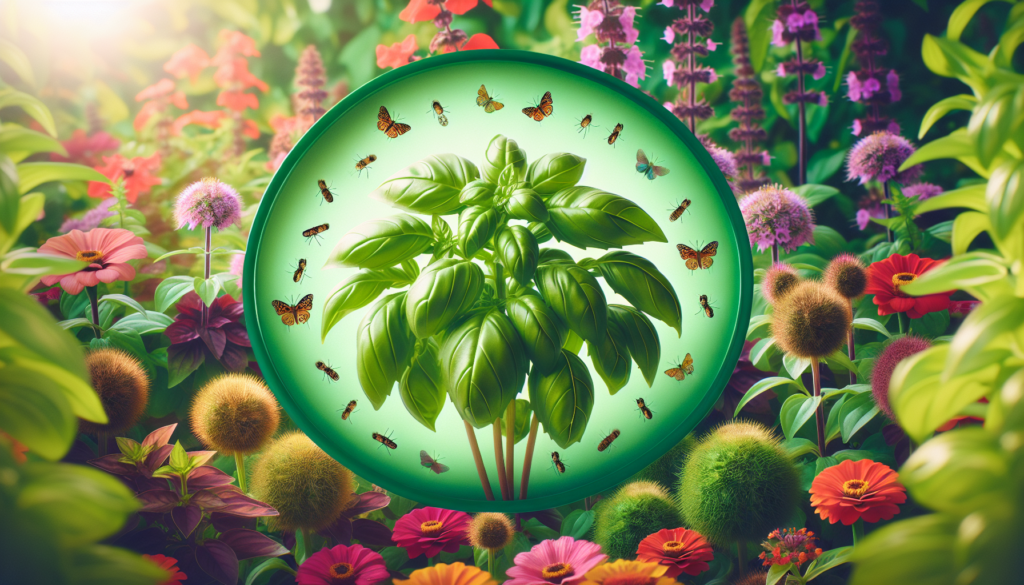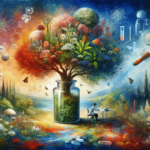If you’re a herb enthusiast and love growing your own basil, one challenge you might face is keeping pesky bugs away from your beloved plant. Fortunately, there are natural methods you can employ to protect your basil from unwanted guests. From companion planting to homemade sprays, this article will provide you with some effective and eco-friendly solutions to ensure your basil stays bug-free and thriving. So, if you’re ready to bid farewell to those bothersome pests and enjoy a flourishing basil garden, read on to discover some simple yet effective ways to keep bugs off your basil naturally.
Natural Pest Control for Basil
Gardening enthusiasts know just how frustrating it can be when pesky insects wreak havoc on their beloved basil plants. Not only do these pests cause damage to the leaves and stems, but they can also ruin the flavor and quality of the herbs we grow in our gardens. While chemical pesticides may seem like a quick fix, they can harm the environment and our health in the long run. That’s why it’s essential to explore natural pest control methods for basil, which not only protect our plants but also promote a healthy and eco-friendly garden.
Understanding Common Basil Pests
Before we delve into the various natural pest control methods, it’s crucial to familiarize ourselves with the common pests that plague basil plants. By understanding the characteristics and habits of these intruders, we can effectively implement strategies to keep them at bay.
Some of the most common basil pests include aphids, whiteflies, spider mites, and snails. Aphids are small, soft-bodied insects that suck the sap from the leaves, causing them to curl and turn yellow. Whiteflies also feed on the sap of the plant, and their presence can be identified by the white powdery residue they leave behind. Spider mites, on the other hand, create tiny webs and feed on the undersides of the leaves, causing them to dry out and turn yellow. Lastly, snails and slugs feast on the basil leaves, leaving behind irregular holes and damaged foliage.
The Benefits of Using Natural Pest Control
While chemical pesticides may provide immediate relief from basil pests, they come with several drawbacks. Not only can these synthetic compounds harm beneficial insects and pollinators, but they can also contaminate the soil, air, and even our food. Natural pest control methods offer a safer alternative, minimizing the negative impact on the environment and our health.
By using natural pest control, we can maintain a balanced and sustainable ecosystem in our garden. Beneficial insects, such as ladybugs, lacewings, and parasitic wasps, can help control basil pests naturally. Additionally, by creating an environment that attracts these helpful insects, we can let nature take its course and reduce the need for pesticides altogether.

Creating an Environmentally Friendly Garden
To successfully implement natural pest control for your basil plants, creating an environmentally friendly garden is crucial. By adopting sustainable practices and understanding the interconnectedness of plants, insects, and the environment, you can create a thriving ecosystem that keeps harmful pests at bay.
1. Attract Beneficial Insects
One of the most effective ways to control basil pests naturally is by attracting beneficial insects to your garden. These insects prey on pests, keeping their populations in check without the need for chemical interventions. To attract beneficial insects, you’ll need to identify them and create an environment that suits their needs.
Identifying Beneficial Insects
Ladybugs, also known as lady beetles, are excellent predators of aphids, mites, and other small insects that feed on basil plants. These brightly colored insects feast on pests during both their larval and adult stages, making them valuable allies in natural pest control.
Lacewings are another beneficial insect that feeds on aphids, mites, and small caterpillars. Their larvae, which are often referred to as “aphid lions,” are voracious predators and can consume a large number of pests in a short period.
Parasitic wasps, although small and often unnoticed, are highly effective in controlling pest populations. These tiny wasps lay their eggs inside or on the bodies of certain pests, eventually killing them. These natural predators help control a variety of basil pests, including aphids, caterpillars, and whiteflies.
Planting Beneficial Insect Attractants
To attract beneficial insects, it’s essential to provide them with the conditions they need to thrive. Planting a variety of flowers, herbs, and other beneficial insect attractants near your basil plants will help create an inviting environment for these helpful creatures.
Some beneficial insect attractants include marigolds, sunflowers, dill, fennel, and yarrow. These plants not only provide nectar and pollen for beneficial insects but also serve as host plants for some species. By incorporating these plants into your garden, you can increase the presence of beneficial insects and enhance natural pest control for your basil plants.

2. Companion Planting
Companion planting involves strategically planting certain plants next to one another to maximize their growth and repel pests. By carefully choosing compatible companion plants for basil, we can create an environment that deters pests and promotes the health of our plants.
Choosing Compatible Companion Plants
When selecting companion plants for basil, it’s essential to consider their growth habits, compatibility, and pest-repelling properties. Plants that have a natural resistance to common basil pests or emit strong scents that repel insects are ideal companions.
Some compatible companion plants for basil include:
- Marigolds: Marigolds have a strong scent that repels aphids, nematodes, and other harmful insects. Planting marigolds near your basil can help deter these pests and create a pest-free zone.
- Nasturtiums: Nasturtiums are known to repel aphids, whiteflies, and squash bugs. Planting these colorful flowers near your basil can help protect them from these common pests.
- Petunias: Petunias are known for their ability to repel aphids, tomato hornworms, and Colorado potato beetles. Planting petunias alongside your basil can provide a natural barrier against these pests.
Companion Plants to Repel Basil Pests
In addition to repelling general garden pests, there are companion plants specifically known to deter pests that commonly affect basil.
- Borage: Borage repels tomato hornworms, cabbage worms, and other pests that can damage basil plants. Consider planting borage near your basil to help protect it from these pests.
- Catnip: Catnip, besides being attractive to cats, repels aphids, flea beetles, and squash bugs. Planting catnip near your basil can help keep these common pests at bay.
- Chives: Chives repel aphids, Japanese beetles, and carrot rust flies. Interplanting chives with your basil can help deter these pests and create a healthier garden environment.
3. Practicing Crop Rotation
Crop rotation involves moving plants within the same family to different areas of your garden each growing season. This practice disrupts the life cycle of pests and diseases, reducing the likelihood of recurring infestations.
Benefits of Crop Rotation
Crop rotation offers several benefits for basil plants and natural pest control. By rotating the location of your basil plants, you lessen the chance of pests and diseases becoming established and thriving in the same area year after year.
Additionally, crop rotation can help restore soil fertility and structure, as different plant families have varying nutrient requirements. This ensures that your basil plants receive the necessary nutrients for healthy growth, reducing stress and making them less susceptible to pests and diseases.
Implementing a Crop Rotation Plan for Basil
To effectively practice crop rotation for your basil plants, it’s important to understand which plant families belong to the same rotation group. Basil, along with other herbs like rosemary, thyme, and oregano, belongs to the mint family (Lamiaceae). Therefore, it’s best to rotate your basil plants with other plants from different families, such as tomatoes, beans, or lettuce.
When planning your crop rotation, aim for a four-year cycle where you do not plant basil in the same area until four years have passed. This break in planting locations helps disrupt the life cycle of basil pests and diseases, reducing their impact and promoting healthier plant growth.
4. Using Homemade Natural Sprays
Homemade natural sprays can be effective in controlling basil pests while avoiding synthetic chemicals. These sprays are made from organic ingredients commonly found in our kitchens and gardens.
Garlic and Chili Pepper Spray
A popular homemade spray for repelling pests is the garlic and chili pepper spray. To make this natural concoction, blend several cloves of garlic and a few chili peppers with water. Allow the mixture to steep overnight, then strain it into a spray bottle. Spray the mixture directly onto the affected basil plants, making sure to coat both sides of the leaves.
This spray is an effective deterrent for aphids, whiteflies, and spider mites, as these pests are repelled by the strong smell and taste of garlic and chili peppers. It’s important to reapply the spray every couple of days or after rainfall to ensure continued protection.
Neem Oil Spray
Neem oil, derived from the neem tree, is a natural insecticide and repellent that can be used to control basil pests. To make a neem oil spray, dilute pure neem oil according to the manufacturer’s instructions and mix it with water in a spray bottle. Thoroughly spray the diluted neem oil onto the basil plants, making sure to target the pests and their larvae.
Neem oil is effective against a wide range of pests, including aphids, whiteflies, and spider mites. It works by disrupting the pests’ feeding and reproductive cycles, ultimately leading to their demise. Regular application is key to fully control and eradicate the pests.
Soap Solution Spray
A simple soap solution can also be effective in controlling basil pests. Mix a few drops of liquid dish soap with water in a spray bottle and shake well. Spray the soapy water directly onto the pests, making sure to thoroughly coat them. The soap solution works by suffocating and dehydrating the pests, leading to their removal.
This spray is particularly useful for controlling soft-bodied pests like aphids, whiteflies, and spider mites. However, it’s important to test the solution on a small area of the plant first to ensure that the soap concentration is not too strong, as it can damage the basil leaves.
5. Applying Organic Insecticides
While homemade sprays can be effective, some severe pest infestations may require the use of organic insecticides. These products are derived from natural sources and are specifically designed to target and eliminate pests while minimizing harm to beneficial insects and the environment.
Bacillus Thuringiensis (BT)
Bacillus thuringiensis, commonly known as BT, is an organic insecticide that specifically targets caterpillars, such as those that feed on basil leaves. It contains a bacterium that produces toxins lethal to the caterpillars but harmless to humans, wildlife, and beneficial insects. BT is available in powder or liquid form, and it should be applied directly to the affected areas of your basil plants according to the package instructions.
By using BT, you can effectively control caterpillar pests like cabbage loopers and hornworms without resorting to harsh chemicals. Monitor your basil plants closely for caterpillar activity, and promptly apply BT at the first signs of an infestation.
Diatomaceous Earth
Diatomaceous earth is a natural insecticide made from crushed fossils of marine organisms called diatoms. It is highly effective in controlling a wide range of crawling insects, including snails and slugs that can damage basil plants. Diatomaceous earth works by dehydrating and physically damaging the exoskeletons of pests, leading to their demise.
To use diatomaceous earth, simply dust it around the base of your basil plants or directly onto the pests. Make sure to reapply after rainfall or as needed, as it loses its effectiveness when wet. Take care not to inhale the dust, as it can irritate the respiratory system.
6. Providing Adequate Water and Nutrients
Healthy basil plants are less susceptible to pests and diseases, so it’s important to provide them with adequate water and nutrients to promote vigorous growth and resilience.
Watering Basil Plants Properly
Basil plants prefer consistently moist soil, but overwatering can lead to root rot and other issues. To strike the right balance, water your basil plants when the top inch of soil feels dry. Water deeply, ensuring that the entire root system is thoroughly moistened. Avoid overhead watering, as this can create a humid environment that attracts pests and diseases.
Proper watering not only keeps your basil plants healthy, but it also helps them withstand pest attacks. Well-hydrated plants are less stressed and more resilient, making them less susceptible to pest damage.
Fertilizing Basil Plants Naturally
Providing your basil plants with the necessary nutrients can help them grow strong and resist pest infestations. Instead of using synthetic fertilizers, opt for natural and organic alternatives.
Organic compost, rich in nutrients and beneficial microorganisms, is an excellent choice for fertilizing basil plants. Apply a layer of compost around the base of your plants, being careful not to cover the stems. As the compost breaks down, it releases nutrients that nourish the basil and improve soil health.
Additionally, you can use organic liquid fertilizers, such as fish emulsion or seaweed extract, to provide a nutrient boost to your basil plants. Apply these fertilizers according to the product instructions to ensure adequate absorption by the plants.
7. Regularly Inspecting and Handpicking Pests
Regular inspection and handpicking of pests can be an effective and satisfying method of pest control. By identifying and removing pests promptly, you can prevent them from causing significant damage to your basil plants.
Identifying Common Basil Pests
Familiarizing yourself with the common pests that infest basil plants is crucial for successful pest control. Keep an eye out for aphids, whiteflies, spider mites, snails, and any irregularities in the appearance of your basil plants.
Aphids are small, pear-shaped insects that cluster on the undersides of leaves or along stems. They come in various colors, including green, yellow, and black.
Whiteflies are tiny, flying insects that look like small moths. They can be identified by the white powdery residue they leave behind when disturbed.
Spider mites are microscopic pests that are often seen as tiny dots or specks on the foliage. They can cause webbing on the undersides of leaves and, with severe infestations, lead to yellowing and bronzing of foliage.
Snails and slugs can be easily spotted by their slimy trails and damage they cause, leaving irregular holes in the basil leaves.
Handpicking and Safely Removing Pests
To handpick pests from your basil plants, simply inspect each leaf and stem carefully for signs of infestation. Wear gloves if necessary, as some pests may be small and difficult to handle directly. Carefully remove any affected leaves, checking both sides for pests or eggs. Dispose of the removed leaves in a sealed bag or container to prevent pests from returning to the plants.
For larger pests like snails and slugs, you can create a beer trap by placing shallow dishes filled with beer near your basil plants. The pests will be attracted to the beer and drown in the liquid. Empty and refill the traps as needed to catch more pests.
Regular inspection and handpicking should be part of your routine garden maintenance, allowing you to stay ahead of pest populations and prevent significant damage.
8. Creating Physical Barriers
Physical barriers can be a highly effective way to keep pests away and protect your basil plants. By creating barriers that pests cannot cross, you can prevent them from damaging your precious herbs.
Using Floating Row Covers
Floating row covers are lightweight fabric covers that can be placed over your basil plants, providing a physical barrier against pests. These covers allow sunlight, water, and air to reach the plants while preventing pests from accessing them.
To use floating row covers, simply drape them over a frame or support structure, ensuring that the fabric does not touch the basil leaves. Secure the edges of the covers to the ground using stakes or weights, making sure there are no gaps for pests to enter.
Floating row covers can be effective against a wide range of pests, including insects and larger animals like birds. However, it’s essential to monitor the covers regularly for signs of damage or trapped pests, and to remove them when pollination is necessary.
Building Insect Screens or Netting
Insect screens or netting can also serve as physical barriers to protect your basil plants from pests. These screens can be made from fine mesh or netting material, which prevents pests from coming into contact with your plants.
To construct an insect screen, create a frame using wood or PVC pipes and cover it with the mesh material. Place the screen over your basil plants, ensuring that there are no gaps or openings that pests can exploit.
Insect screens are particularly effective against flying insects like whiteflies and cabbage moths. They provide a comprehensive barrier around your basil plants, keeping them safe and pest-free.
10. Using Natural Repellents
In addition to attracting beneficial insects and implementing physical barriers, natural repellents can also be used to deter pests from attacking your basil plants. These repellents emit scents or substances that pests find unpleasant, encouraging them to stay away.
Citronella and Lemon Balm
Citronella and lemon balm are two fragrant plants that emit strong scents that repel pests. Consider planting these herbs near your basil to create a natural barrier against pests. The strong aroma of citronella and lemon balm can confuse and deter insects, reducing the likelihood of a pest infestation.
Mint and Pennyroyal
Another set of aromatic plants that can repel pests are mint and pennyroyal. These members of the mint family emit a strong odor that deters many harmful insects. Planting mint or pennyroyal near your basil can provide a natural shield against pests and help maintain a healthy garden environment.
Marigolds and Petunias
Marigolds and petunias are known for their pest-repelling properties and vibrant blooms. Planting these flowers near your basil can help keep pests at bay while adding color and beauty to your garden. Marigolds repel aphids and nematodes, while petunias discourage pests like whiteflies and tomato hornworms.
By strategically incorporating these natural repellents into your garden, you can enhance pest control efforts and create a visually pleasing environment.
In conclusion, natural pest control for basil is not only effective but also environmentally friendly. By attracting beneficial insects, implementing companion planting, practicing crop rotation, using homemade sprays and organic insecticides, providing adequate water and nutrients, inspecting and handpicking pests, creating physical barriers, and using natural repellents, you can protect your basil plants from common pests while promoting a healthy and sustainable garden. By adopting these methods, you can enjoy delicious, pest-free basil while contributing to a more balanced and eco-friendly ecosystem. Happy gardening!





